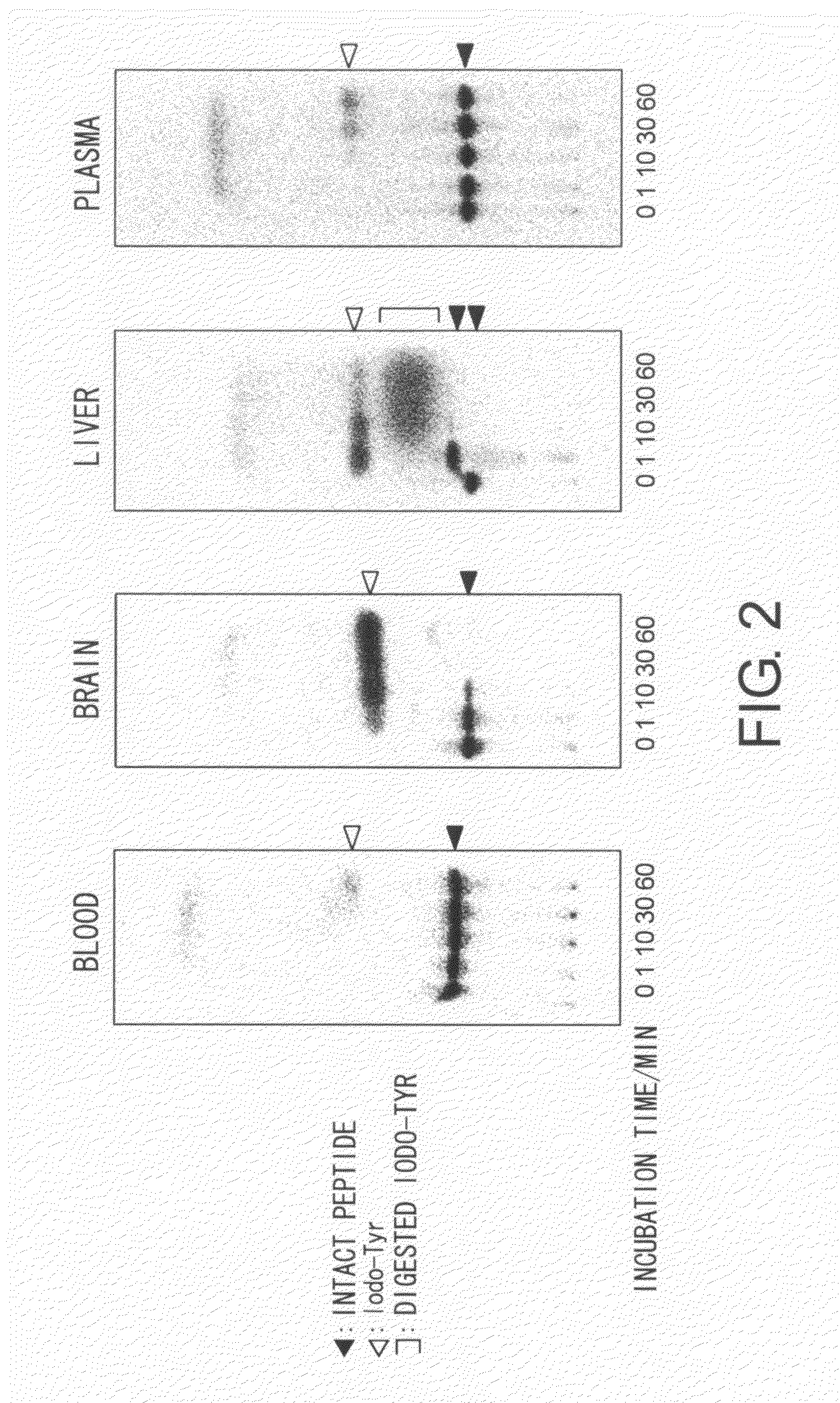Brain-localizing polypeptides comprising a multivalent binding moiety and improved metabolic stability
a technology of brain-localizing polypeptides and metabolic stability, which is applied in the direction of peptide/protein ingredients, drug compositions, and drugs, etc., can solve the problems of adverse effects such as kidney and liver damage, difficult to achieve effective concentration of drugs or such by oral administration or injection, and hardly allow the permeation of blood components. to achieve the effect of improving the metabolic stability of brain-localizing polypeptides
- Summary
- Abstract
- Description
- Claims
- Application Information
AI Technical Summary
Benefits of technology
Problems solved by technology
Method used
Image
Examples
example 1
Metabolism Tests Using RI-Labeled Peptides
[0161]In order for brain-localizing peptides to exhibit their activity, the brain-localizing amino acid motif needs to maintain a cyclic structure. The cyclization may be accomplished by an S-S linkage between the SH groups of cysteines, or an amide bond (peptide bond) formed between the N-terminal α-amino group and C-terminal carboxyl group. The [C]C004CY peptide has a sequence in which the brain-localizing amino acid sequence of SEQ ID NO: 4 is placed between two cysteines (C), and is cyclized by an S-S linkage between the SH groups of cysteines, and carries an added tyrosine (Y) at the C terminus that can be used for iodine labeling. [C] indicates a cyclic structure. On the other hand, the [C]K004K peptide has lysines (K) at both ends of the same brain-localizing amino acid sequence, and is cyclized by the formation of an amide bond (peptide bond) between the N-terminal α-amino group and C-terminal carboxyl group. They are shown in schema...
example 2
In Vitro Metabolism Test
[0169]Results of the in vivo metabolism test showed that the [C]K004K peptide is more stable in vivo compared to [C]C004CY. To compare the degree of improved stability observed in [C]K004K, an experiment system that uses a fluorescent pigment as a tracer instead of an isotope labeling for in vitro evaluation using a mouse liver homogenate was produced.
[0170]The technique is briefly indicated below.
Add two parts of Hanks' solution to one part of mouse liver, and homogenize
↓
Centrifuge and collect supernatant
↓
Add five parts of Hanks' solution (liver extract solution)
↓
Add 5 μL of peptide to 245 μL of liver extract solution
↓
Incubate at 37° C.
[0171]↓
Take 50 μL of sample 0, 5, 30, 60, and 120 minutes after incubation
↓
Add 200 μL, of 70% ethanol (pre-cooled at −30° C.) and then vortex
↓
Add 500 μL of chloroform (pre-cooled at −30° C.) and then vigorously vortex
↓
Centrifuge and collect supernatant
↓
Add an equivalent amount of DMF and then vortex
↓
Centrifuge and collect supe...
example 3
Translocation of Peptides to the Cerebral Parenchyma
[0175]Next, to verify the translocation of [C]K004K into the cerebral parenchyma, [C]([18F]FB-K004K was synthesized by positron-labeling the K004K peptide through reaction of 18F-labeled SFB with the amino group of [C]K004K, and the in vivo brain-localizing characteristic was examined.
[0176][C]([18F]FB)-K004K was synthesized by adding [18F]SFB to [C]K004K and letting this react at room temperature. Approximately 0.57 mCi / 300 μL of the synthesized [C]([18F]FB)-K004K was administered to the right common carotid artery of Sprague-Dawley rats, and they were subjected to micro-PET scanning for 30 minutes to obtain bioimages of the brain.
[0177]As a result, very strong signals were detected only on the side of the brain receiving the administration, and hardly any signals were detected on the other side of the brain and in the cerebellum (FIGS. 6A, B, and C).
[0178]Furthermore, the scanned brain was removed and subjected to ex vivo autorad...
PUM
| Property | Measurement | Unit |
|---|---|---|
| metabolic stability | aaaaa | aaaaa |
| concentration | aaaaa | aaaaa |
| lipid solubility | aaaaa | aaaaa |
Abstract
Description
Claims
Application Information
 Login to View More
Login to View More - R&D
- Intellectual Property
- Life Sciences
- Materials
- Tech Scout
- Unparalleled Data Quality
- Higher Quality Content
- 60% Fewer Hallucinations
Browse by: Latest US Patents, China's latest patents, Technical Efficacy Thesaurus, Application Domain, Technology Topic, Popular Technical Reports.
© 2025 PatSnap. All rights reserved.Legal|Privacy policy|Modern Slavery Act Transparency Statement|Sitemap|About US| Contact US: help@patsnap.com



